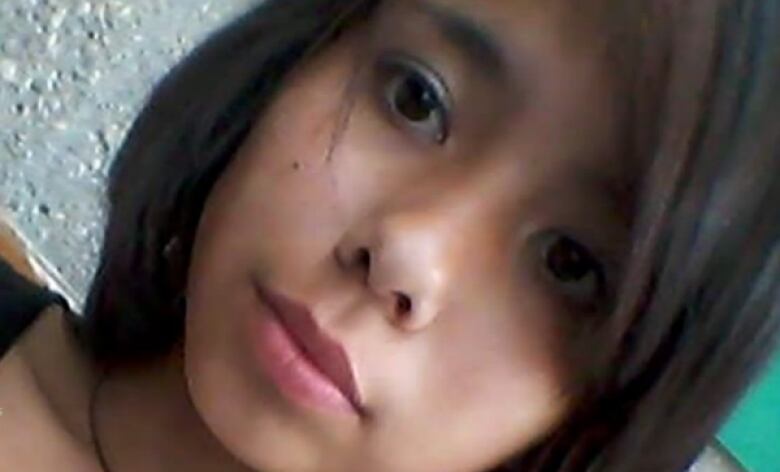Tina Fontaine's death focuses attention on missing, murdered aboriginal women
Issue of violence against aboriginal women has reached boiling point

Eleven years before 15-year-old Tina Fontaine's bodywas pulled from the Red River wrapped in a bag, the same riverbankwas the setting for another tragedy.
Felicia Solomon Osborne didn't return home from school in March 2003.
- Faceless Dolls bring awareness to missing, murdered aboriginal women
- For more aboriginal stories visit cbc.ca/aboriginal
Frustrated by what they felt was lack of action from police infinding the 16-year-old, her family members put up their own missingposters.Three months later, one of Felicia's arms and a leg were pulledfrom the same spot where Tina's body would later be found.
Felicia's killer has never been caught.Neither has Tina's.But a lot has changed when it comes to awareness of the issue ofmissing and murdered aboriginal women.

When Tina's body was discovered in August, Winnipeg police heldan emotional news conference where a sergeant said "society shouldbe horrified" by the violent death of a child.
More than 1,000 people took to the streets to call for action.Dozens camped in the shadow of the Manitoba legislature for weeks asthey repeatedly called for a national public inquiry into missingand murdered aboriginal women. Prime Minister Stephen Harper wasasked about her death.
Issue has reached 'boiling point'
"Nobody connected with Felicia Solomon Osborne and yet that wassome of the most savage levels perpetrated," said Nahanni Fontaine,special adviser on aboriginal women's issues for the Manitoba government. "Her mom, all she got back, was a leg and an arm. Shewas only 16, only a year older than Tina."
The issue reached a boiling point in 2014 with Tina's death andan attack a few months later on 16-year-old Rinelle Harper. Rinelle survived, agreed to be named publicly and has since spoken about theneed to end violence against women.
The RCMP issued a landmark report in 2014 which put the total of missing and murdered aboriginal women at 1,181. Although indigenouswomen make up 4.3 per cent of the Canadian population, the reportfound they account for 16 per cent of female homicides and 11.3 percent of missing women.
"Our message is getting across that this a Canadian problem,"said Alberta regional chief Cameron Alexis with the Assembly ofFirst Nations. "We have to be concerned. There is something wronghere."
Long wait for awareness

That's all changed, she said.
"The conversation has switched. Other people are gettinginvolved that aren't directly connected," Smith said. "When youfind a 15-year-old's body dumped in the river like they're garbage,you start to think maybe that could have been my daughter or mysister or my niece."
Smith has been calling for a national inquiry for years, butafter Tina's death many more joined her.
The federal government has so far refused, saying it is moreinterested in taking action than studying the issue. Prime MinisterStephen Harper has said Tina's death was not part of a"sociological phenomenon," but rather a crime and should betreated as such.
The federal government agreed to attend a roundtable meetingafter Canada's premiers emerged from their annual meeting in Augustcalling for a national forum. It's expected to be held in February.
Hopes are high the issue can sustain public attention well intonext 2015. Advocates suggest the roundtable, which Harper will notbe attending, is just the beginning.
"I want to say something positive about it it sounds promising but that's about all I can say," said Manitoba Aboriginal AffairsMinister Eric Robinson. "The federal government has to be really,really serious. They have to come with an open mind and an openheart and not tell us what they've put our money towards.
"I don't want to hear that. I've heard that all my life."
National inquiry will be an election issue
A spokesman for Kellie Leitch, the federal minister responsiblefor the status of women, said the minister was busy with cabinetcommittees and didn't have time for an interview on the subject.
Andrew McGrath sent an emailed statement on Leitch's behalfsaying the government takes crimes against aboriginal women andgirls "very seriously."
He noted the Conservatives have earmarked $25 million over fiveyears on ways to address crimes against aboriginal women. Oneproject is for development of community safety plans both off and onreserves, as well as initiatives to break inter-generational cyclesof violence and abuse.
That isn't likely to be enough to keep the issue from resurfacingin the upcoming federal election, slated for next fall.
Both the Liberals and the Opposition New Democrats have promisedto call a national public inquiry if elected.
Michele Audette, former president of the Native Women's Association of Canada, said she has accepted the roundtable, but theidea for a national inquiry hasn't passed.
"We have so many spokespeople who will bring this issueeverywhere they go," said Audette, who recently stepped down to runfederally for the Liberals. "We have artists. We have musicians. Wehave politicians. We have all kinds of people who will work for thatcause," she said.
"The only (side) ... missing right now is the Harper government."That's the way it is."












_(720p).jpg)


 OFFICIAL HD MUSIC VIDEO.jpg)
.jpg)



























































































